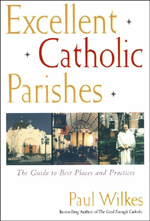At the outset it seems just plain weird to leaf through a customer’s guide to religious congregations. Pick your place of worship by the stylishness with which its ministers confect the holy eucharist? Entrust your soul’s health to a congregation on the basis of the immediacy of its presentation of God’s word or the effectiveness of its outreach to the poor? Yet a sort of Zagat’s guide on where to go to church is, among other things, what Paul Wilkes has produced in these two volumes.
 Wilkes, a veteran writer on the contemporary American religious scene, especially Roman Catholic, and himself a practicing Catholic layman, explains that he got the idea for this project after he delivered a series of talks at the Church of the Presentation, Upper Saddle River, New Jersey, and found himself in the midst of “a wonderful, spirit-filled place” rich with a vibrancy sadly lacking in his home congregation (the name of which he tactfully omits). Surely there were other congregations like Presentation. Where were they and what made them excellent?
Wilkes, a veteran writer on the contemporary American religious scene, especially Roman Catholic, and himself a practicing Catholic layman, explains that he got the idea for this project after he delivered a series of talks at the Church of the Presentation, Upper Saddle River, New Jersey, and found himself in the midst of “a wonderful, spirit-filled place” rich with a vibrancy sadly lacking in his home congregation (the name of which he tactfully omits). Surely there were other congregations like Presentation. Where were they and what made them excellent?
Fortified by a grant from the Lilly Endowment (which is also a generous supporter of In Trust) and two research assistants, Marty Minchin and Melanie Bruce, Wilkes toured the national landscape and came up with a list of 600 churches he deemed excellent, 300 each for these companion volumes, Excellent Catholic Parishes and Excellent Protestant Congregations. (Both volumes are subtitled The Guide to Best Places and Practices.)
Why should Wilkes’s two guides be of interest and concern to theological school trustees, administrators, and faculty members? Because many, perhaps most, of the students they are now educating are the future professional leaders of congregations. Are these students being equipped, should these students be equipped, to lead their congregations—or better, collaborate with their congregations—on a pilgrimage into a life of what Wilkes deems excellence?
Wilkes provides dimension and detail to his ideas of excellence by profiles in the two books of eight Catholic churches, a Missouri Synod Lutheran church, an Episcopal church, a Southern Baptist church, a United Methodist church, an Evangelical Presbyterian church, a Chinese union church, a Full Gospel church, and two nondenominational congregations. Neither book is “about theory—or trends or statistics—but about practice, practical application,” he writes. “It is meant to be a sort of survival guide for pastors and church leaders. For as we sought excellence, we sought reproducible excellence. What we would look for in these churches would be approaches and programs that could be replicated in other places.”
Although Wilkes assesses excellence slightly differently in the two books, its marks are much the same in both guides. Among the marks: a pastor who has been in place a long time, strong lay leaders whose leadership the pastor affirms, a congregational understanding of itself as a mission outpost, and a busy community life that is fully engaged with the world but ultimately, at its center, is focused on spirituality and spiritual growth. “Excellent churches provide the tools and the support to forge a real, living, and enduring relationship with the Almighty,” he writes. “Called by many names, the reality is the same: God can be a part of your life, and these churches will help make it so.”
Wilkes writes from the perspective, one widely held by theologians of all persuasions, that the center of Christian life is the local congregation. The congregations he rates as excellent have in a variety of ways made effective contact with a new generation of Americans and become havens, homes, and beacons in a civil society in which many, in their more honest moments, admit they feel lonely, hopeless and lost.
Which returns me to another version of the question I posed at the outset of this review. Reading these books as a theological school official, do you agree with Wilkes that the congregations he singles out are excellent? Has your school prepared its graduates to build and serve congregations like these? These books are food for thought. And perhaps soul food as well.